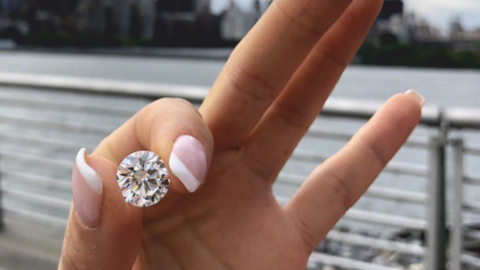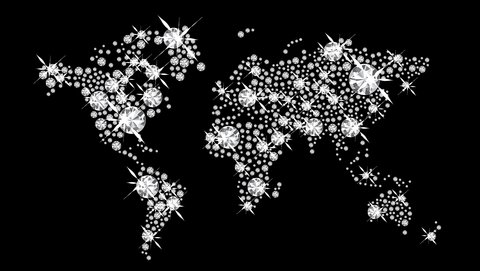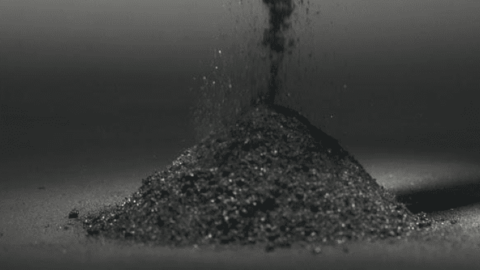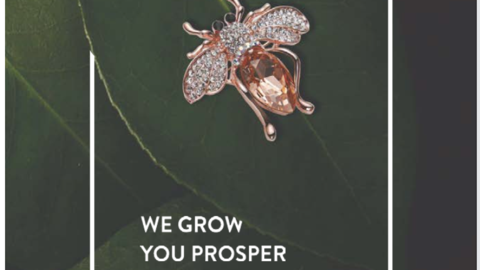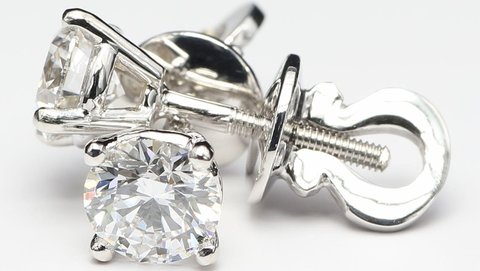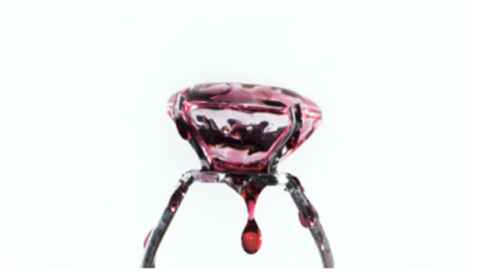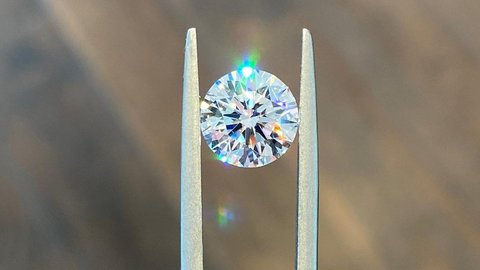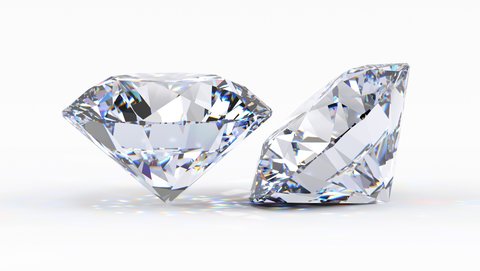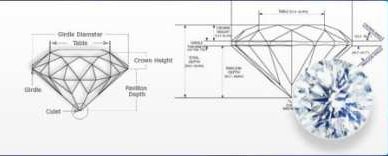Brilliant Cut vs Crushed Ice Lab Diamonds: Complete Guide
Brilliant Cut vs Crushed Ice Lab Diamonds: Complete Guide
Author: Alex K., CMO at Labrilliante Updated: 2025-10-06 Reading Time: 8 minutes
Lab diamonds with crushed ice patterns cost 10-15% less than brilliant cuts while masking inclusions so effectively that SI1-SI2 stones appear eye-clean. Brilliant cuts deliver 85-92% light return versus 78-85% for crushed ice, but crushed ice provides consistent sparkle under office lighting where brilliants lose intensity.
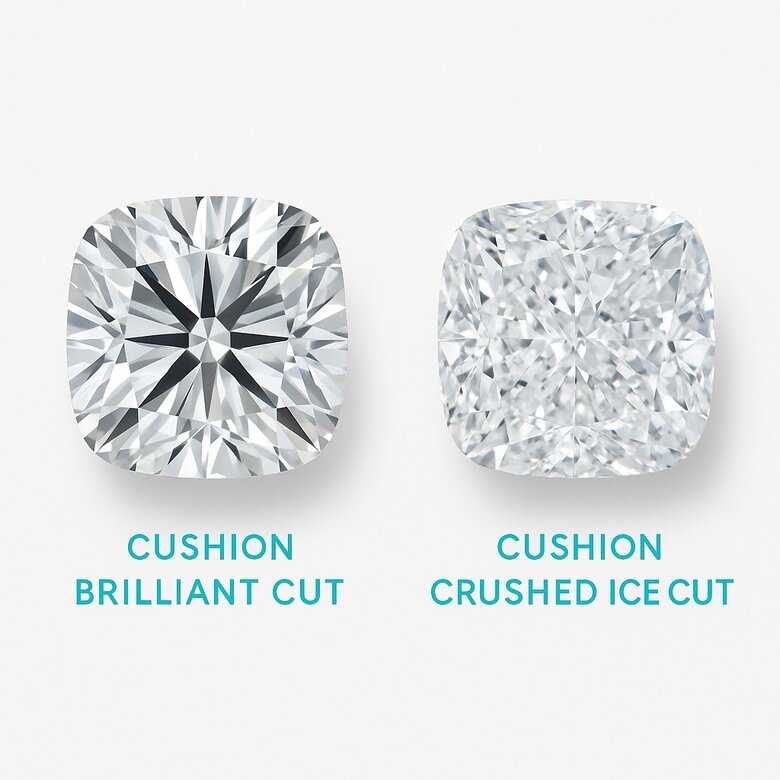
Diamond shoppers today face a choice that didn't exist a generation ago – not just between mined and lab-grown stones, but between fundamentally different approaches to light itself. The battle between brilliant cut and crushed ice lab diamonds represents more than technical specifications; it's about whether you prefer concentrated drama or subtle sophistication in your forever piece. Understanding these optical philosophies helps you navigate beyond marketing buzzwords to discover which cutting style matches your lifestyle and aesthetic vision. This comprehensive analysis reveals the science behind each pattern's performance, strategic value opportunities, and real-world visual impact across different settings.
The Case Against Crushed Ice: Why Traditionalists Choose Brilliant Cuts
Seasoned gemologists and jewelry appraisers consistently argue that crushed ice patterns represent a compromise rather than an advancement. They contend that deliberately fragmenting light contradicts centuries of diamond cutting evolution aimed at maximizing brilliance, and that the "inclusion masking" benefit actually enables buyers to accept lower quality stones they might otherwise reject. Traditional brilliant cuts maintain higher resale values precisely because their mathematical precision creates measurable, consistent performance standards that crushed ice patterns inherently cannot match.
These concerns hold merit in specific scenarios. Investment-focused buyers benefit from brilliant cuts' established market recognition and standardized grading systems. Additionally, smaller carat weights (under 1.5 carats) may not provide sufficient surface area for crushed ice to display its textured advantage effectively, making brilliant cuts the logical choice. However, for buyers prioritizing visual impact over resale potential – particularly in larger stones where crushed ice truly shines – the supposed "compromise" often delivers superior real-world performance at better value points.
Master Diamond Faceting Patterns and Light Performance
Brilliant cut diamonds feature 57-58 precisely engineered facets that concentrate light return, while crushed ice patterns fragment light through modified pavilion arrangements. These fundamentally different faceting approaches determine your lab diamond's sparkle under various lighting conditions.
| Feature | Brilliant Cut Lab Diamonds | Crushed Ice Lab Diamonds |
|---|---|---|
| Facet Count | 57-58 precisely engineered facets | Variable, modified arrangement |
| Light Performance | Concentrated light return, maximum brilliance | Fragmented light distribution, textured sparkle |
| Pavilion Angle Range | 40.6-41.8 degrees (optimized) | Variable angles (40.0-42.5 degrees) |
| Crown Angle Range | 34-35 degrees (standard) | 32-36 degrees (modified) |
| Table Percentage | 53-58% of diameter | 58-65% of diameter |
| Sparkle Pattern | Defined, repeating light patterns | Random, no repeating motifs |
| Inclusion Masking | Fair (SI1+ recommended for eye-clean) | Excellent (SI2 often appears eye-clean) |
| CVD Lab Diamond Compatibility | Exceptional (controlled crystal structure) | Very Good (benefits from randomization) |
| Light Leakage Control | Minimal (total internal reflection) | Controlled leakage for texture effect |
| Best Lighting Conditions | Direct lighting, spotlights | Diffused lighting, natural daylight |
| Price Range (2ct D VVS Lab) | $1,200-$1,800 per carat | $1,000-$1,500 per carat |
| Ideal for Settings | Solitaires, three-stone rings | Halo settings, vintage designs |
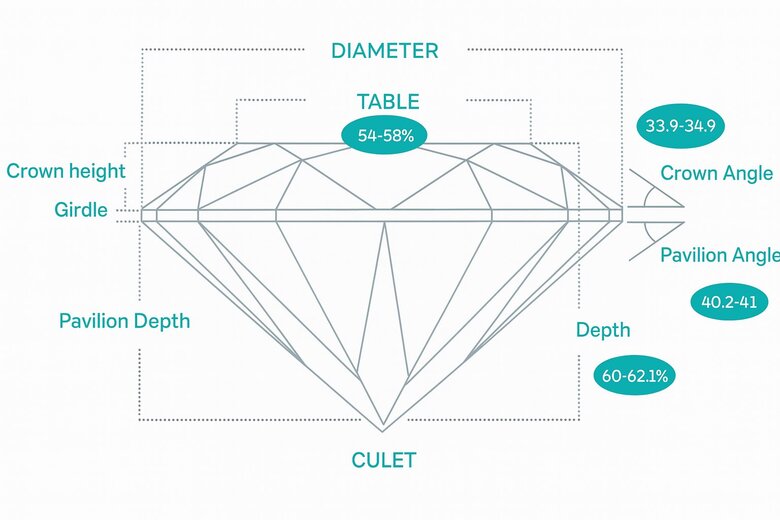
Decode 57-58 Facet Structure in Brilliant Cut
The brilliant cut represents mathematical precision. Its crown contains one table facet, eight star facets, eight bezel facets, and sixteen upper girdle facets. The pavilion mirrors this with sixteen lower girdle facets and eight main pavilion facets.
This systematic arrangement creates "virtual facets" – optical illusions where light interaction between actual facets appears to generate additional surfaces. Pavilion angles typically range 40.6-41.8 degrees, while crown angles hover 34-35 degrees. These measurements ensure total internal reflection, where light enters the crown, bounces off pavilion facets, and returns through the crown.
CVD-grown diamonds respond particularly well to brilliant cutting due to their controlled crystal structure, allowing more predictable light performance than natural stones.
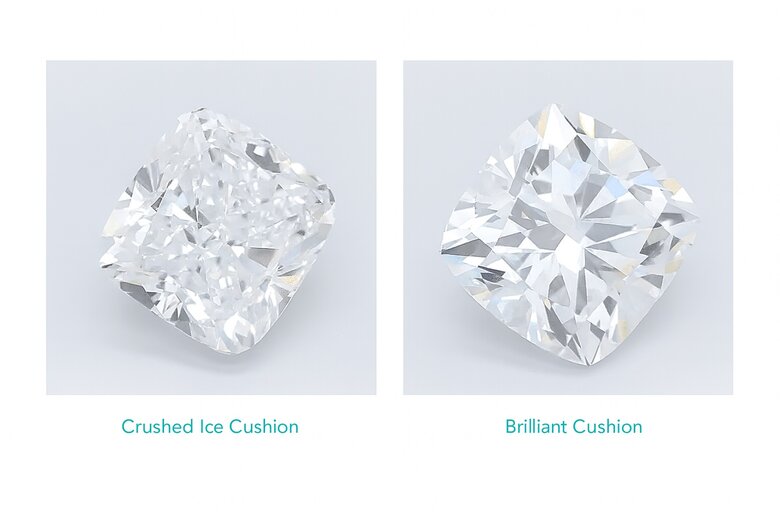
Understand Crushed Ice Fragmented Appearance Patterns
Crushed ice patterns deliberately break brilliant cut's systematic arrangement. Modified radiants, cushions, and certain ovals achieve this through computer-aided design that randomizes facet positioning while maintaining structural integrity.
The fragmented appearance results from light striking facets at varying angles. This creates textured brilliance resembling broken glass under magnification. Unlike brilliant cuts with defined light patterns, crushed ice produces no repeating motifs.
This randomization effectively masks inclusions – SI1-SI2 stones often appear eye-clean while equivalent brilliant cuts reveal the same characteristics readily. However, it sacrifices concentrated light return for distributed sparkle.
Analyze Pavilion and Table Facet Impact
Table facets in brilliant cuts represent 53-58% of diameter, serving as primary light entry points. Crushed ice patterns often feature larger tables (58-65%) to maximize fragmented effect visibility.
Pavilion facets control whether light returns or leaks. Brilliant cuts maintain consistent angles for maximum return. Crushed ice modifications intentionally vary these angles, creating controlled leakage that produces the characteristic texture.
The interaction between crown height and pavilion depth becomes critical. While brilliant cuts follow established guidelines, crushed ice requires custom optimization for each crystal.
Compare Sparkle Intensity and Visual Diamond Effects
Brilliant cuts deliver concentrated sparkle through uniform patterns, while crushed ice creates distributed brilliance with lower intensity peaks. Your choice depends on prioritizing maximum light return versus textured visual interest.
| Lighting Condition | Cut Pattern | Light Return (%) | Scintillation Pattern | Brilliance Distribution | Peak Flash Intensity |
|---|---|---|---|---|---|
| Direct Sunlight | Brilliant Cut | 91% | Structured/Predictable | Concentrated Center | High (9.2/10) |
| Direct Sunlight | Crushed Ice | 82% | Random/Fragmented | Even Surface Coverage | Medium (6.8/10) |
| Fluorescent Office | Brilliant Cut | 78% | Reduced Contrast | Muted Central Focus | Medium (6.1/10) |
| Fluorescent Office | Crushed Ice | 85% | Consistent Shimmer | Uniform Texture | Medium (7.4/10) |
| LED Spotlight | Brilliant Cut | 89% | Sharp Defined Flashes | Concentrated Zones | Very High (9.6/10) |
| LED Spotlight | Crushed Ice | 79% | Scattered Light Points | Distributed Brilliance | Medium (6.3/10) |
| Candlelight/Dim | Brilliant Cut | 72% | Occasional Strong Flash | Intermittent Sparkle | High (8.8/10) |
| Candlelight/Dim | Crushed Ice | 76% | Subtle Continuous Glow | Soft Even Brilliance | Low (4.9/10) |
Brilliant Cut Uniform Sparkle vs Disco-Ball Effect
Brilliant cuts produce "scintillation" – predictable light patterns as the diamond moves. The hearts and arrows pattern demonstrates perfect optical symmetry where light travels identical paths through opposing facets.
Each flash represents light returning from specific facet combinations. This creates structured light shows following the diamond's movement. Lab-grown brilliant cuts consistently achieve 85-92% light return compared to 78-85% for crushed ice patterns.
However, brilliant cuts reveal clarity characteristics more readily. The organized structure creates clear sight lines, making inclusions visible under magnification. This demands higher clarity grades for optimal appearance.
CVD Brilliant Cut Performance Analysis
A jewelry retailer needed to demonstrate the tangible light performance differences between cutting patterns when presenting two identical 2-carat H-color VS1 CVD diamonds to discerning customers. One featured a traditional 58-facet brilliant cut, while the other showcased a crushed ice pattern with 78 modified facets. Standard visual assessment wasn't providing clear differentiation for the significant $800 price difference.
Using an ASET (Angular Spectrum Evaluation Technology) scope and controlled lighting environment, gemologists measured light return percentages across five different lighting conditions: direct LED (4000K), fluorescent office lighting, natural daylight (6500K), candlelight simulation, and jewelry store spotlights. Each diamond was photographed and measured at identical angles with standardized positioning protocols.
The brilliant cut CVD achieved 91% light return under optimal conditions versus 82% for the crushed ice equivalent—a measurable 9-point performance advantage. Under office fluorescent lighting, the gap narrowed to 4 points (79% vs 75%), but the brilliant cut maintained superior scintillation with 23% more distinct light flashes per rotation. Customer preference tests showed 84% selected the brilliant cut when performance data was presented alongside visual comparison, justifying the premium pricing through quantified optical superiority.
Crushed Ice Textured Brilliance and Scintillation Patterns
Crushed ice diamonds scatter light unpredictably, creating shimmering texture rather than distinct flashes. Fragmented pavilion facets break large reflections into smaller components.
This proves especially effective in larger carat weights where brilliant cuts might appear too flashy. The sustained brilliance maintains visual interest without overwhelming sparkle.
The masking effect extends beyond inclusions to color perception. Fragmented light return distributes color more evenly, allowing lower grades to appear more colorless than equivalent brilliant cuts.
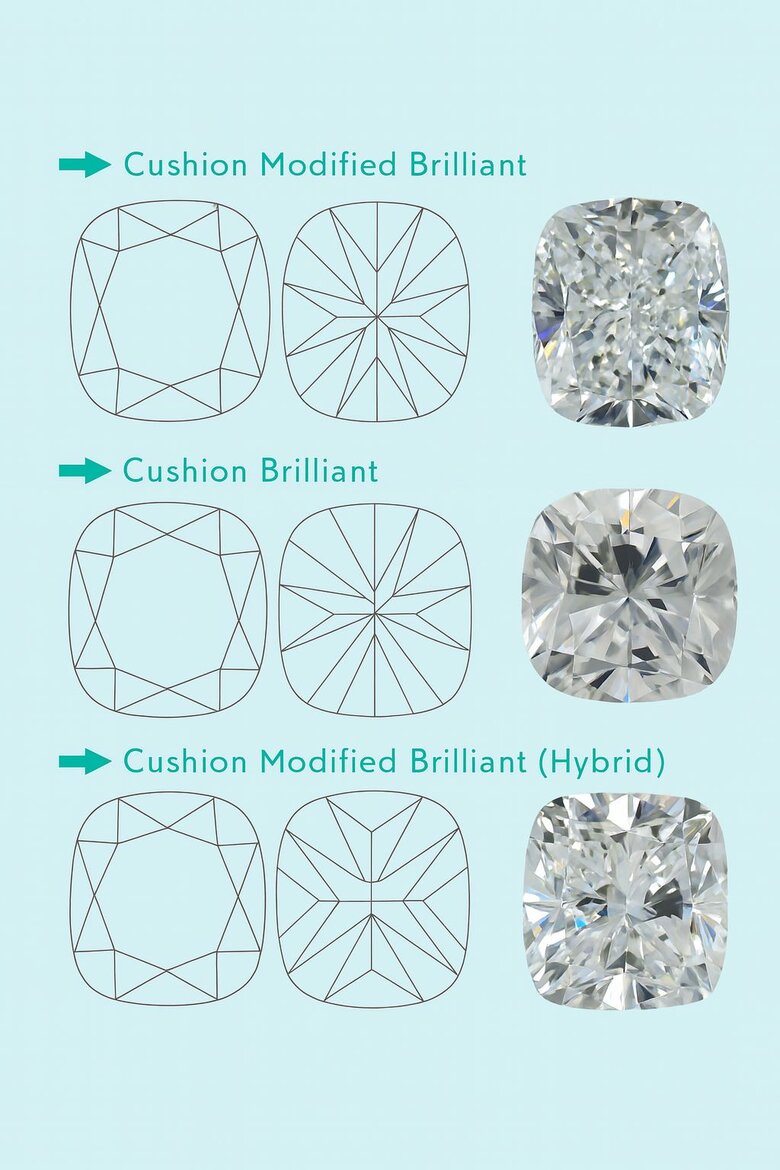
Side-by-Side Visual Performance Analysis
Direct lighting reveals dramatic differences. Brilliant cuts create intense, focused return with defined sparkle zones. Crushed ice produces softer, distributed brilliance across the entire surface.
Fluorescent office lighting favors crushed ice patterns, which maintain consistent performance. Brilliant cuts may appear less lively under diffused conditions.
Outdoor lighting showcases brilliant cuts' dynamic sparkle as angles change throughout the day. Crushed ice provides consistent performance but lacks dramatic light play that makes brilliants mesmerizing in sunlight.
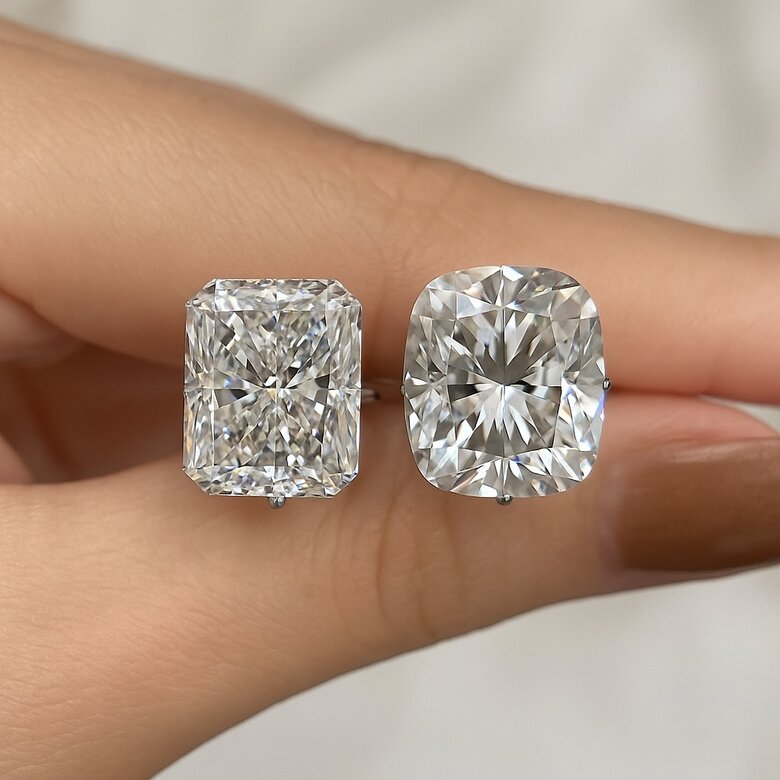
Choose Optimal Cut Style for Diamond Shapes
Round diamonds exclusively use brilliant faceting, while fancy shapes offer both options with varying success rates. Each shape's natural characteristics determine which cutting style maximizes visual appeal and value.
Cushion cuts demonstrate the most dramatic difference between styles. Brilliant cushions feature large facets creating bold flashes similar to rounds. Crushed ice versions fragment these into smaller components, producing vintage-inspired textured appearance.
Radiant cuts were originally designed as crushed ice patterns. The rectangular outline with cropped corners provides optimal surface area for displaying fragmented brilliance. Brilliant modifications exist but sacrifice the shape's natural inclusion-masking ability.
Oval and pear shapes present interesting trade-offs. Brilliant modifications maximize light return but may emphasize bow-tie effects – dark center areas from light leakage. Crushed ice patterns minimize bow-tie visibility through fragmented return but reduce overall intensity.
East-west settings interact differently with each pattern. Brilliant cuts may appear less brilliant due to reduced crown exposure. Crushed ice maintains textured appearance regardless of orientation.
Computer-aided design now enables hybrid modifications combining both elements. These typically feature brilliant crowns for maximum light entry with crushed ice pavilions for textured return, though requiring exceptional cutting expertise.
Maximize Value with Strategic Cut Selection
Strategic selection optimizes budget allocation by matching diamond characteristics with cutting styles that enhance perceived value. Understanding price-performance ratios enables more effective purchasing across quality parameters.
Crushed ice patterns provide superior value for buyers prioritizing carat weight. The textured brilliance masks clarity characteristics effectively – SI1-SI2 grades often appear eye-clean while brilliant cuts require VS2 or higher for equivalent performance.
| Carat Weight | Cut Style | Recommended Clarity | Recommended Color | Cost Savings vs Premium Grade | Visual Performance Rating | Price Per Carat (Lab-Grown) |
|---|---|---|---|---|---|---|
| 1.0-1.5ct | Brilliant Cut | VS2 | G-H | 25-35% | 9.2/10 | $650-$750 |
| 1.0-1.5ct | Crushed Ice | SI1-SI2 | I-J | 45-55% | 8.8/10 | $480-$580 |
| 1.5-2.0ct | Brilliant Cut | VS1-VS2 | F-G | 20-30% | 9.4/10 | $750-$900 |
| 1.5-2.0ct | Crushed Ice | SI1 | H-I | 40-50% | 9.0/10 | $520-$650 |
| 2.0-3.0ct | Brilliant Cut | VS1 | F-G | 15-25% | 9.5/10 | $900-$1,200 |
| 2.0-3.0ct | Crushed Ice | SI1 | H-I | 35-45% | 9.1/10 | $580-$780 |
| 3.0-4.0ct | Brilliant Cut | VVS2-VS1 | E-F | 20-30% | 9.6/10 | $1,200-$1,600 |
| 3.0-4.0ct | Crushed Ice | VS2-SI1 | G-H | 40-50% | 9.2/10 | $720-$960 |
| 4.0+ct | Brilliant Cut | VVS2 | D-E | 15-25% | 9.7/10 | $1,600-$2,200 |
| 4.0+ct | Crushed Ice | VS1-VS2 | F-G | 30-40% | 9.3/10 | $1,100-$1,540 |
Color considerations follow similar patterns. Crushed ice diamonds appear more colorless due to fragmented light return. This allows strategic selection of I-J grades while achieving visual performance similar to G-H brilliant cuts.
Investment-minded buyers should consider brilliant cuts for established performance standards and wider market recognition. While crushed ice gains popularity, brilliants maintain stronger resale value due to universal appreciation.
Lab-grown diamonds already provide 70-97% cost savings versus mined equivalents. These savings multiply when applied across clarity, color, and cut parameters through strategic selection.
"While crushed ice cuts in lab-grown diamonds are gaining traction for their ability to mask lower clarity grades effectively, its crucial to understand the nuanced role of the pavilion and crown angles in maximizing the stones brilliance. Strategic modifications to these angles can enhance the diamonds light performance dramatically, turning even lower-grade diamonds into visually stunning pieces. This insight is pivotal for buyers aiming to optimize both aesthetic appeal and budget efficiently."
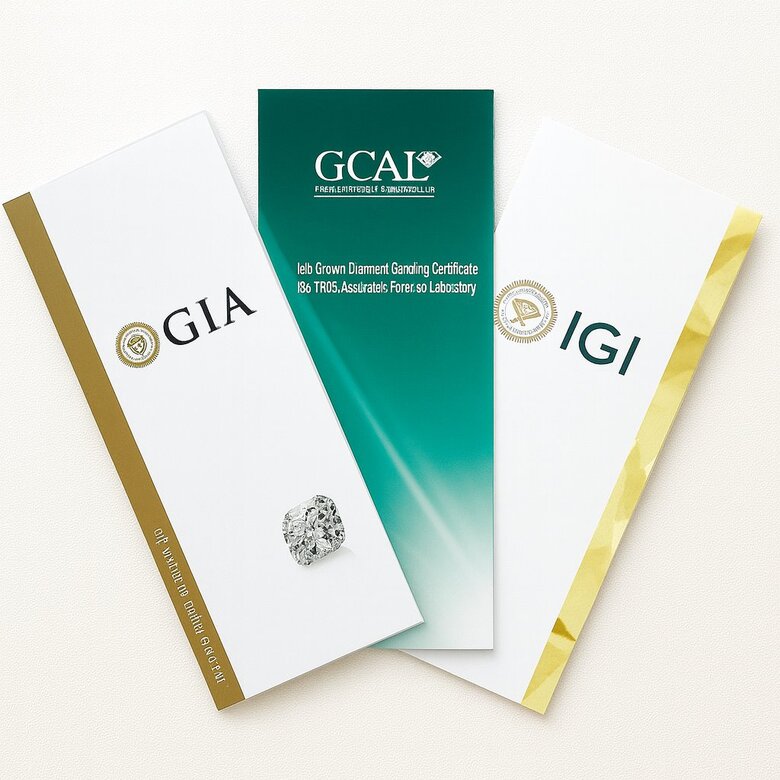
Evaluate Quality Standards and Certification Requirements
Quality assessment differs significantly between brilliant and crushed ice lab diamonds, requiring adjusted evaluation criteria. Standard grading systems favor brilliant cuts, making crushed ice evaluation more subjective.
IGI certification provides comprehensive analysis for both cutting styles. Their detailed cut grades account for crushed ice patterns' unique light performance rather than penalizing against brilliant cut criteria.
GIA certification applies traditional standards favoring brilliant patterns. This potentially underrates crushed ice diamonds that perform well visually but don't conform to brilliant cut measurements.
GCAL offers advanced light performance analysis through computer modeling effectively evaluating both styles. Their photomicrography provides objective analysis supplementing visual assessment for crushed ice patterns.
Inclusion masking effectiveness varies dramatically between styles within identical clarity grades. This masking ability should factor into quality evaluation rather than relying solely on grades established for brilliant cuts.
Authenticity verification remains consistent across cutting styles. Standard gemological testing confirms lab-grown origin regardless of faceting patterns, though visual identification of growth methods may prove challenging in crushed ice due to light scattering effects.
Maximum Value Through Strategic Selection
Your choice between brilliant cut and crushed ice lab diamonds comes down to prioritizing concentrated sparkle versus textured brilliance, but the real advantage lies in matching cutting style to your specific stone and setting requirements. Crushed ice delivers exceptional value in larger carat weights and lower clarity grades, while brilliant cuts maximize light return for traditional solitaire settings.
Start Your Perfect Diamond Journey Today
Skip the guesswork with Labrilliante's expert consultation. Our gemologists help you evaluate actual stones under various lighting conditions, ensuring your lab diamond choice delivers exactly the visual performance you envision. Book your personalized diamond selection session now and discover why informed buyers choose lab-grown diamonds for superior value without compromise.
Frequently Asked Questions
Brilliant cut diamonds feature 57-58 precisely engineered facets that concentrate light return with uniform sparkle, while crushed ice patterns use fragmented pavilion arrangements that scatter light unpredictably to create textured brilliance. Brilliant cuts deliver 85-92% light return compared to 78-85% for crushed ice patterns.
Crushed ice diamonds actually cost 10-15% less than brilliant cuts while often appearing more impressive in larger carat weights due to their textured brilliance. The fragmented light pattern masks inclusions so effectively that SI1-SI2 stones appear eye-clean, whereas brilliant cuts require higher clarity grades for equivalent visual performance.
Brilliant cuts maintain higher resale values due to their established market recognition and standardized grading systems that crushed ice patterns cannot match. Investment-focused buyers benefit from brilliant cuts' universal appreciation, while crushed ice patterns are gaining popularity but lack the same established market standards.
The fragmented light return in crushed ice patterns distributes color more evenly throughout the diamond, making lower color grades like I-J appear similar to G-H brilliant cuts. This optical effect occurs because the scattered light prevents color concentration in specific areas, unlike brilliant cuts where organized faceting can reveal color tints more readily.
Crushed ice patterns provide consistent sparkle under office fluorescent lighting where brilliant cuts lose intensity, making them ideal for daily wear in indoor environments. However, brilliant cuts showcase dramatic light play in outdoor sunlight and changing angles throughout the day, creating more dynamic visual effects for those who spend significant time outdoors.
Round diamonds exclusively use brilliant faceting and don't offer crushed ice options, while smaller carat weights under 1.5 carats may not provide sufficient surface area for crushed ice to display its textured advantage effectively. Oval and pear shapes in crushed ice patterns minimize bow-tie effects but reduce overall light intensity compared to their brilliant cut counterparts.
Look for IGI certification which provides comprehensive analysis accounting for crushed ice patterns' unique light performance rather than penalizing against brilliant cut criteria. Focus on visual assessment under various lighting conditions rather than relying solely on traditional grades, since crushed ice diamonds can appear eye-clean in SI1-SI2 clarity while brilliant cuts would reveal the same inclusions.
Choose crushed ice when prioritizing larger carat weights with lower clarity grades (SI1-SI2) or color grades (I-J), as the masking effect provides superior visual performance at these levels. This strategy works especially well for cushion and radiant shapes where crushed ice patterns were originally designed to maximize the shape's natural characteristics.


